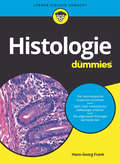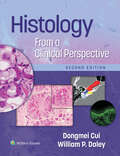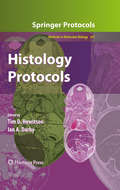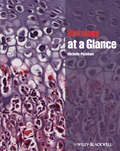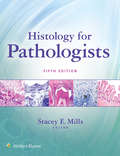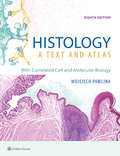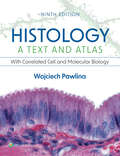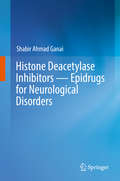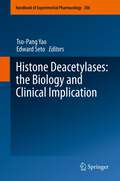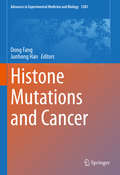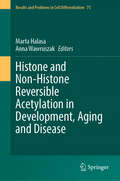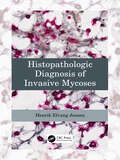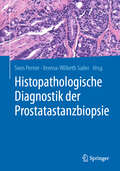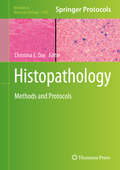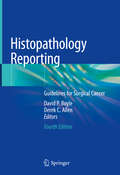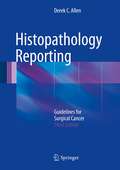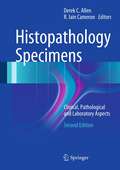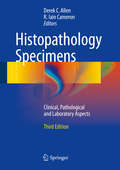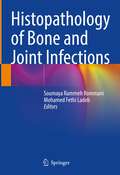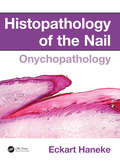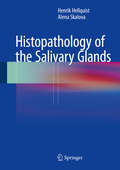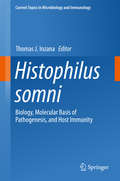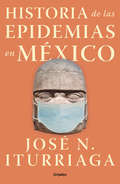- Table View
- List View
Histologic Basis of Ocular Disease in Animals
by Bruce Grahn Robert Peiffer Brian WilcockHistologic Basis of Ocular Disease in Animals is a comprehensive reference covering pathology of the eye in a spectrum of animal species, including domestic animals, fish, birds, and laboratory animals. Offers a comprehensive resource on diseases and conditions of the eye and orbit in a wide range of species Covers domestic animals, fish, birds, and laboratory animals Presents more than 1200 high-quality images carefully selected to illustrate the ocular conditions covered Emphasizes unique pathological responses where necessary
Histologie für Dummies (Für Dummies)
by Hans-Georg FrankSie müssen sich mit Histologie beschäftigen? Dann hilft Ihnen dieses Buch. Hans-Georg Frank erklärt Ihnen, was Sie über medizinische Zellbiologie, allgemeine Histologie und mikroskopische Anatomie wissen sollten. Dabei folgt er dem üblichem Aufbau des Themas in der universitären Ausbildung und so eignet sich dieses Buch auch hervorragend als Lernskript. Stets so verständlich wie möglich, dabei exakt, ist Ihnen dieser Titel auch eine große Hilfe, wenn Sie sich mit Histologie bisher nicht oder nur am Rande auseinandergesetzt haben und den Stoff bis zum Physikumsniveau beherrschen wollen. Zahlreiche farbige Abbildungen helfen dabei den Inhalt zu veranschaulichen.
Histology From a Clinical Perspective
by Dongmei Cui William P. DaleyCombining a complete histology atlas with a concise, clinically oriented text, Histology from a Clinical Perspective, 2nd Edition, integrates essential basic science information and related pathology to ensure mastery of fundamental histology topics and the confidence to apply concepts effectively in practice. Explanatory text in each chapter is paired with expanded figure legends in an innovative layout that presents light and electron micrographic images of a tissue, a diagrammatic representation of the same tissue, and an example of how the tissue may be modified by a pathologic process in abundant Clinical Correlations. Rich with clinical vignette USMLE-style review questions and additional self-assessment resources, this student-friendly approach reflects the most up-to-date clinical perspectives and instills the understanding and skills to excel in today’s clinical settings.
Histology Protocols
by Ian A. Darby Tim D. HewitsonWith much of what we know about the pathogenesis of disease coming from the systematic and careful study of histological material, histology has proven to be an incredibly valuable area of study. In "Histology Protocols", expert researchers in the field contribute detailed methods involving the preparation of tissue, providing an overview of fixation, embedding, and processing, along with the required techniques for the retrieval of RNA from histological sections, followed by sections on routine and specialist histological staining techniques, including immuno-, lectin, and hybridization histochemistry, histological staining, as well as specific methods for the in situ identification of hypoxia and apoptosis, and details on the advances in imaging and image analysis. Written in the highly successful Methods in Molecular BiologyTM series format, chapters include introductions to their respective topics, lists of the necessary materials and reagents, step-by-step, readily reproducible laboratory protocols, and notes on troubleshooting and avoiding known pitfalls. Authoritative and cutting-edge, "Histology Protocols" will provide molecular biologists with the basic histochemical techniques and histologists with the molecular techniques necessary to realize the potential of their resource.
Histology at a Glance (At A Glance Ser. #50)
by Michelle PeckhamThis brand new title provides a highly illustrated and unambiguous introduction to the science, structure and function of cells, their related pathology, and in particular, helps readers master the basic principles of recognizing features of histological sections. Histology at a Glance: Presents the perfect combination of text and image; key concepts are explained and superbly illustrated Provides coverage of all the main body systems and the components of the tissues of these systems Features practical information on microscopy, including sample preparation and magnification Includes hints and tips to help recognize features in a histological specimen, and overcome common difficulties Contains self-assessment questions to help test learning and recognition Links to the author's histological website, which features many more tips and samples, at www. wiley. com/go/histologyataglance Histology at a Glance is the perfect guide for medical, dentistry and biomedical science students, junior doctors, and is ideal for independent learning programmes in histology.
Histology for Pathologists
by Stacey MillsFilled with more than 1,000 images, the latest edition of this award-winning comprehensive classic—written by anatomic pathologists for anatomic pathologists—has been updated with new information on surgical principles and techniques. Like previous editions, the book is designed to bridge the gap between normal histology and pathologic alterations.
Histology: With Correlated Cell and Molecular Biology
by Wojciech Pawlina Michael H. RossPublisher's Note: Products purchased from 3rd Party sellers are not guaranteed by the Publisher for quality, authenticity, or access to any online entitlements included with the product. Combining a reader-friendly textbook and a rich, full-color atlas, this bestselling resource equips medical, dental, health professions, and undergraduate biology and cell biology students with a comprehensive grasp of the clinical and functional correlates of histology and a vivid understanding of the structural and functional details of cells, tissues, and organs. Updated content throughout the text reflects the latest advances in cellular and molecular biology, accompanied by large, high-resolution illustrations and full-color photomicrographs that clarify microanatomy in vibrant detail. Ideal for integrated curriculums as well as standalone histology courses, this proven approach is accompanied by popular pedagogical features that distill complex information and help students save time.
Histology: With Correlated Cell and Molecular Biology
by Wojciech PawlinaCombining a reader-friendly textbook and a rich, full-color atlas, Histology: A Text and Atlas: With Correlated Cell and Molecular Biology, 9th Edition, equips medical, dental, health professions, and undergraduate biology and cell biology students with a comprehensive grasp of the clinical and functional correlates of histology and a vivid understanding of the structural and functional details of cells, tissues, and organs. The 9th Edition of this bestselling resource reflects the latest advances in cellular and molecular biology and relevant imaging techniques, accompanied by large, high-resolution illustrations and full-color photomicrographs that clarify microanatomy in vibrant detail. System chapters align conveniently with curricula units and emphasize a clinical context, making this proven approach ideal for integrated curricula as well as standalone histology courses. To accommodate reviewers’ suggestions, the ninth edition integrates new information in cell biology with clinical correlates, which readers will see as new clinical information items highlighted in blue text and in clinical boxes (called “Folders”). For example, the last few years of the COVID-19 pandemic has sparked interest about the changes in normal tissue when infected by the severe acute respiratory syndrome coronavirus 2 (SARS-CoV-2) virus. Several chapters contain descriptions of these changes with underlying explanations of cellular and molecular mechanisms and clinical features presented by patients. Additional changes include the following: A new discussion on the mononuclear phagocytic system and the cell biology of resident tissue macrophage has been added. The latest research findings in immune cell activation have been incorporated. Updated cellular biology topics include beige adipose tissue, the epithelial–mesenchymal transition, conjunctiva- associated lymphatic tissue, biogenesis and function of peroxisomes, and microsomes as the newest discovered form of cell-to-cell communication. New, more detailed information about the histology of the female and male external genitalia has been included. The skin chapter has been supplemented and updated with many new additions, including of skin color and aging. With the constant improvement in microscopic methods, a new basic discussion on three-dimensional (3D) microscopy methods was incorporated in the methods chapter.
Histone Deacetylase Inhibitors in Combinatorial Anticancer Therapy
by Shabir Ahmad GanaiThis book reviews the latest developments in the design, synthesis, and molecular mechanism of action of Histone Deacetylase (HDAC) inhibitors in the context of potential cancer therapy. HDAC inhibitors are emerging as promising anticancer drug molecules that promote growth arrest, differentiation and apoptosis of cancer cells with tumor selective toxicity. The book begins with an overview of various epigenetic modifying enzymes that are involved in cancer transition and progression; before exploring the potential of HDACs in cancer treatment. It provides a classification of HDAC inhibitors based on their structural attributes, and addresses HDAC-induced cytotoxicity.. Lastly, it discusses and assesses the rationale behind therapies that combine HDAC inhibitors with other anticancer agents to treat solid tumors. Given its scope, it offers a valuable resource for all researchers, clinicians, and students working in formulation, drug discovery, oncology, and personalized medicine.
Histone Deacetylase Inhibitors — Epidrugs for Neurological Disorders
by Shabir Ahmad GanaiThis book provides an outline of epigenetics as a whole, while also specifically examining a range of epigenetic players, including histone acetyl transferases (HATs) and histone deacetylases (HDACs). It chiefly focuses on the emerging targets of HDACs and their implications for various neurological disorders, while also discussing the drawbacks of current therapeutic strategies, the classification of HDAC inhibitors, and their promising effects in connection with specific neurological disorders. The book explores the potential use of these inhibitors as novel therapeutic agents, considers the current challenges involved in using them to tackle neurological complications, and offers a novel solution by designing isoform-selective inhibitors and employing combinatorial therapeutic strategies. Its final section, which explores future directions, elaborates on the possibility of enhancing HDAC inhibitors’ therapeutic efficacy against various neurological complications.
Histone Deacetylases: the Biology and Clinical Implication
by Edward Seto Tso-Pang YaoThe book highlights work from many different labs that taught us abnormal HDACs potentially contribute to the development or progression of many human diseases including immune dysfunctions, heart disease, cancer, memory impairment, aging, and metabolic disorders.
Histone Mutations and Cancer (Advances in Experimental Medicine and Biology #1283)
by Dong Fang Junhong HanThis book focuses on histone mutations, especially those mutations closely related to cancer. Genetic mutations and epigenetic alterations contribute to the development of a variety of cancers: recent genetic studies have identified e.g. H3K27M and H3G34R/V mutation in over 75% of DIPG cases, H3.3K36M mutation in more than 90% of chondroblastoma cases, and H3G34W/L mutation in over 90% of giant cell tumors of bone. Given the high incidence and tumorigenesis effects of histone H3 mutations, they are also referred to as oncohistones.This book highlights the advances made in the area over the past 10 years, and offers a state-of-the-art summary of epigenetic alternation, gene expression, protein structure, drug discovery, immunotherapy, and mouse modeling of histone H3 mutations in various tumors. Chiefly intended to provide researchers and graduate students with an overall picture of these mutations, it will also be of interest to researchers in basic oncology, clinical oncology, and epigenetics, as well as academics and clinical oncology practitioners.
Histone and Non-Histone Reversible Acetylation in Development, Aging and Disease (Results and Problems in Cell Differentiation #75)
by Marta Halasa Anna WawruszakThis volume explores various aspects of reversible acetylation of histone and non-histone proteins, focusing on their roles in development, ageing and disease progression. It examines the biological consequences of modulating acetylation levels by histone acetyltransferases (HATs) and histone deacetylases (HDACs). Covered are manipulations at multiple levels, from in vitro and in vivo studies to clinical trials and FDA-approved therapies. The book is divided in four parts: Part I provides an overview of post-translational modifications in the context of development, ageing, neurodegenerative and cancer-related diseases. It highlights the role of histone acetylation in higher genome organization and explores the functions of the proteins involved. Part II focuses on the modulation of cytoskeleton-associated proteins through reversible acetylation. It examines how acetylation influences cytoskeletal compartments, thereby regulating cellular structure and function. Part III examines acetylation in the context of development. It describes acetylation as a key regulator of early embryogenesis, influencing chromatin structure and gene expression. Part IV discusses physiological and pathological aspects of histone and non-histone protein acetylation and its modulation by activators and inhibitors. The book is a valuable resource for scientists, clinicians and academic teachers alike.
Histopathologic Diagnosis of Invasive Mycoses
by Henrik Elvang JensenWritten by one of the very few pathologists who has real expertise in this field, this book is a comprehensive key for the identification of fungal infections in tissues. With updated terminology and presentation, all invasive mycoses-types are covered, detailing their epidemiology, pathology, histomorphology of fungal elements, and differential diagnoses. Each of the separate fungal groups has a good combination of text and high-quality illustrations which is a critical feature for clinicians to state the mycopathological diagnoses. Key Features:1. Elaborates on the histological observations of both the pathological reaction and the histomorphology of fungal elements, guiding the reader in the right direction for obtaining a diagnosis of the infection.2. Includes key observations that can be a game-changer for infectious diseases specialists and histopathologists studying the combination of fungal morphology and host response.3. Follows a logical layout, structure, and organization with a wealth of high-quality illustrations of the various fungi in tissues elucidated by different stains.
Histopathologische Diagnostik der Prostatastanzbiopsie
by Sven Perner Verena-Wilbeth SailerDieses Buch zur Prostatapathologie gibt einen umfassenden Überblick über den aktuellen Stand der Diagnostik und der wichtigsten molekularen Veränderungen sowohl des lokalisierten als auch des fortgeschrittenen und metastasierten Prostatakarzinoms. Einsteiger und Fortgeschrittene aus der Pathologie, der Radiologie, der Urologie und auch der Onkologie, können ihre Kenntnisse zu aktuellen Entwicklungen in der Diagnostik, der Molekularpathologie sowie zu klinischen Behandlungskonzepten des Prostatakarzinoms erweitern und vertiefen. Das Praxisbuch vereint das aktuelle theoretische Wissen Gewebeuntersuchung und Befunderstellung mit der praktischen Arbeit an repräsentativen Abbildungen. Neben Standards zur Aufarbeitung und Befundung von Stanzbiopsien, transurethralen Resektaten und radikalen Prostatektomiepräparaten werden immunhistochemische Zusatzuntersuchungen, diagnostische Pitfalls und molekularpathologische Aspekte diskutiert.Wissen auf den Punkt gebracht: die histopathologische Diagnostik der Prostatastanzbiopsie –praxisnah und wissenschaftlich fundiert. Für Pathologen, Urologen und Onkologen.
Histopathology
by Christina E. DayHistopathology: Methods and Protocols provides a comprehensive guide to the current issues in histopathology. With chapters on organ-based approaches with specific protocols for morphologic, molecular examination and pathological observations governing the therapeutic management of the diseases. Written in the highly successful Methods in Molecular Biology series format, chapters include introductions to their respective topics, lists of the necessary materials and reagents, step-by-step, readily reproducible laboratory protocols and tips on troubleshooting and avoiding known pitfalls. Authoritative and practical, Histopathology: Methods and Protocols seeks to be a useful reference for pathologists, pathology residents and fellows as well as to the clinicians and scientists.
Histopathology Reporting: Guidelines for Surgical Cancer
by Derek C. Allen David P. BoyleThis book is an easily comprehensible and practicable framework for standardised histopathology reports in surgical cancer. The pathological features of the common carcinomas are detailed and non-carcinomatous malignancies are also summarised. 8th edition TNM and WHO classifications of cancers are incorporated, with comments on any associated pathology, diagnostic clues and prognostic criteria supplemented visually by line diagrams.Each chapter’s introduction gives epidemiological, clinical, investigative and treatment summary details. Other pathology includes updated immunophenotypic expression and molecular techniques. The impact of these ancillary investigations on diagnosis, and as biomarkers of prognosis and prediction of response to treatment is summarised, as is the effect of adjuvant treatments on cancers. Experience based clues are given throughout as aids to tumour typing, grading, staging, and gauging prognosis and response to treatment. Histopathology Reporting: Guidelines for Surgical Cancer, Fourth Edition is invaluable for trainee and consultant diagnostic histopathologists all over the world, equipping the reader to produce high quality, clinically appropriate histopathology reports, and to participate in contemporary multidisciplinary team management of patients with surgical cancer.
Histopathology Reporting: Guidelines for Surgical Cancer
by Derek C AllenAn easily comprehensible and practicable framework for standardised histopathology reports in surgical cancer. The pathological features of the common carcinomas are detailed and non-carcinomatous malignancies are also summarised. 7th edition TNM and WHO classifications of cancers are incorporated, with comments on any associated pathology, diagnostic clues and prognostic criteria supplemented visually by line diagrams. Each chapter's introduction gives epidemiological, clinical, investigative and treatment summary details. Other pathology includes updated immunophenotypic expression and molecular techniques. The impact of these ancillary investigations on diagnosis, and as biomarkers of prognosis and prediction of response to treatment is summarised, as is the effect of adjuvant treatments on cancers. Experience based clues are given throughout as aids to tumour typing, grading, staging, and gauging prognosis and response to treatment. Histopathology Reporting: Guidelines for Surgical Cancer, Third Edition is invaluable for trainee and consultant diagnostic histopathologists all over the world, equipping the reader to produce high quality, clinically appropriate histopathology reports, and to participate in contemporary multidisciplinary team management of patients with surgical cancer.
Histopathology Specimens
by Derek C. Allen Iain R CameronCovering anatomical, clinical, pathological and laboratory aspects of surgical histopathology specimens, Histopathology Specimens: Clinical, Pathological and Laboratory Aspects, Second Edition relates specimen dissection and its clinical context to relevant histopathology reports, and therefore a more comprehensive patient prognosis and management is possible. Histopathology Specimens: Clinical, Pathological and Laboratory Aspects, Second Edition explains pathological and clinical terminology, including a glossary of clinical request form abbreviations. A standardised step-wise approach to specimen handling is illustrated with simple line diagrams and highlights essentials of the histopathology report, relating them to appropriate specimen dissection. The integrated multidisciplinary team approach taken to the modern clinical management of patients is reflected by correlating patient presentation, diagnostic and staging investigations with histopathology specimens. Current WHO and TNM tumor classifications are referenced. Histopathology Specimens: Clinical, Pathological and Laboratory Aspects, Second Edition will be of educative value and act as a reference tool for the medical undergraduate student, medical trainee in histopathology and the biomedical scientist, and as a useful aide memoire for the histopathology consultant.
Histopathology Specimens
by Derek C. Allen R. Iain CameronCovering anatomical, clinical, pathological and laboratory aspects of surgical histopathology specimens, this book relates specimen dissection and its clinical context to relevant histopathology reports, and therefore a more comprehensive patient prognosis and management is possible. Histopathology Specimens - Clinical, Pathological and Laboratory Aspects explains pathological and clinical terminology, including a glossary of clinical request form abbreviations. It offers a standardised step-wise approach to specimen handling illustrated by simple line diagrams and highlights essentials of the histopathology report, relating them to appropriate specimen dissection. This book will act as a reference tool for the medical trainee in histopathology and the biomedical scientist, and as a useful aide memoire for the histopathology consultant.
Histopathology of Bone and Joint Infections
by Mohamed Fethi Ladeb Soumaya Rammeh RommaniThis book focuses on histopathological features of bone and joint infections. Bone and joint infection is a serious health problem that has increased in the past two decades. Their diagnosis requires the collaboration of physicians, radiologists, microbiologists and pathologists. Symptoms of these lesions are nonspecific often resulting in a delayed diagnosis. Radiology is needed for the diagnosis of bone and joint infection, determining the severity and extent of disease. The radiological diagnosis of these infections is challenging because of multiple overlaps with tumor etiologies.Effective antibiotic treatment relies on the detection of the causative organisms and its their susceptibility testing. However, culture is time consuming. Besides, administering antibiotics prior to performing surgery or biopsy, the low virulent bacteria, tissues contaminations and sampling errors limit the reliability of bone culture. Histology is a key tool for the diagnosis of boneand joint infection by evaluating the tissue reaction pattern caused by the pathogen. The histopathological diagnosis is based on the evaluation of the tissue changes and the leukocyte infiltration pattern.The purpose of this book will be to report in detail the histopathological features of bone and joint infections with emphasis on key diagnostic features and differential diagnoses. It will also highlight special stain and other ancillary tests that can be used as an aid in the histological diagnosis.
Histopathology of the Nail: Onychopathology
by Eckart HanekeThis comprehensive review of the histopathology of the human nail will act as a masterclass for all dermatologists, dermatopathologists, and nail-interested pathologists who have to interpret histological sections of nail tissue, which can be challenging for many reasons. In addition to a wealth of illustrated examples, the text guides the reader through the specialized terminology of nail science and supplies clinical data to help reach a reliable histopathological diagnosis.
Histopathology of the Salivary Glands
by Henrik Hellquist Alena SkalovaOver the last 25 years it has become more and more evident that salivary gland pathology is by far the subject within head and neck pathology that causes most diagnostic challenges and problems for general pathologists. During courses the author has given, consultants and trainees alike have expressed the lack of a comprehensive, useful book on salivary gland pathology. Such a book needs to be broad and to illustrate almost every variant of all tumor entities. Another important feature to incorporate is the newly gained knowledge about genetics in salivary gland tumors, a knowledge that has emerged during the last 3-4 years only (and is growing continuously). A mapping of the immunophenotypes of salivary gland tumors is neither available today and will greatly benefit in routine diagnostic work.
Histophilus somni
by Thomas J. InzanaThis volume reviews the current understanding of the taxonomy, disease syndromes, genetics, biology, and pathogenic factors of Histophilus somni, as well as the host immune response to this pathogen. H. somni is one of the most important bacterial pathogens in cattle and other ruminants, and its virulence factors are highly conserved with Haemophilus influenzae and other members of the Pasteurellaceae. H. somni has been recognized as a major cause of thrombotic meningoencephalitis, respiratory disease syndromes, myocarditis, reproductive disease syndromes, polyarthritis, mastitis, ocular disease, and septicemia. The only known habitats of H. somni are the mucosal surfaces of ruminants, making this bacterium an opportunistic pathogen. Although it is capable of causing inflammation at systemic sites and is toxic to epithelial and phagocytic cells, the bacterium's wide array of virulence factors act primarily as a defense against, or to escape recognition from, host innate and adaptive immunity.
Historia de las epidemias en México
by José N. Iturriaga«La Historia debe ser una lección del pasado para afrontar y orientar el presente e inducir [...] el futuro que deseamos», escribe Iturriaga. Fiel a este precepto, en este libro encontraremos no solo una compilación de las enfermedades más relevantes en México, sino herramientas para abordar nuestro presente y, por tanto, nuestro futuro a medio y largo plazo. Este volumen ofrece un recorrido cronológico por las epidemias que asolaron México desde la época prehispánica hasta nuestros días. Aunque son innumerables las investigaciones acerca de la historia de eventos epidémicos en el país, no existía hasta ahora un volumen compendioso, para un público no especializado y de atractiva lectura sobre la materia. José N. Iturriaga se ha dado a la tarea de estudiar a profundidad las fuentes y traducir toda esa información en un solo tomo dirigido al público general. Desde las conocidas de manera genérica como pestes en el periodo precolonial (cocoliztles, en náhuatl), hasta el cólera morbus, la fiebre amarilla o la influenza española, el autor se detiene brevemente, pero con absoluto rigor, en cada una de estas enfermedades que marcaron a la población mexicana a través de los siglos.

